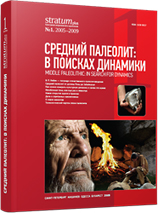Средний палеолит Алтая: вариабельность и эволюция
The Middle Paleolithic of Altai: variability and evolution
Author(s): Evgeny P. Rybin, Kseniya A. KolobovaSubject(s): History, Archaeology
Published by: Издательский дом Stratum, Университет «Высшая антропологическая школа»
Keywords: Gorny Altai; Northern Asia; Palaeolithic localities; Eurasia; Middle Palaeolithic industries;
Summary/Abstract: The Gorny Altai is a unique territory in Northern Asia for density of known Palaeolithic localities. So far, the Gorny Altai is the only region in Eurasia with proved and well-documented gradual transformation of Middle Palaeolithic industries into Upper Paleolithic ones. The present article is devoted to identifying the processes involved into the evolution of middle Palaeolithic cultures of the region. It is proved that all stratified Middle Palaeolithic sites of the region are characterized by a combination of the same flaking methods, tool types (including rare types) and similar methods of secondary treatment. Analysis of distribution of the main technical and typological ratios has demonstrated the lack of remarkable differences between lithic industries, which were earlier described as belonging presumably to different variants (facies) of the local Middle Palaeolithic. The identified variability of lithic industries was influenced by different factors, such as raw material procurement, functional purpose of a certain site and chronological position within the Middle Palaeolithic sequence. It is clear that the Middle Palaeolithic of Altai was not a still structure. The available data make it possible to claim that the rate of changes increased during the Kargian stage of the Upper Neo-Pleistocene (OIS 3). Those changes led to the formation of Initial Upper Palaeolithic complexes of a similar appearance.
Journal: Stratum plus. Археология и культурная антропология
- Issue Year: 2009
- Issue No: 1
- Page Range: 33-78
- Page Count: 46
- Language: Russian
- Content File-PDF

